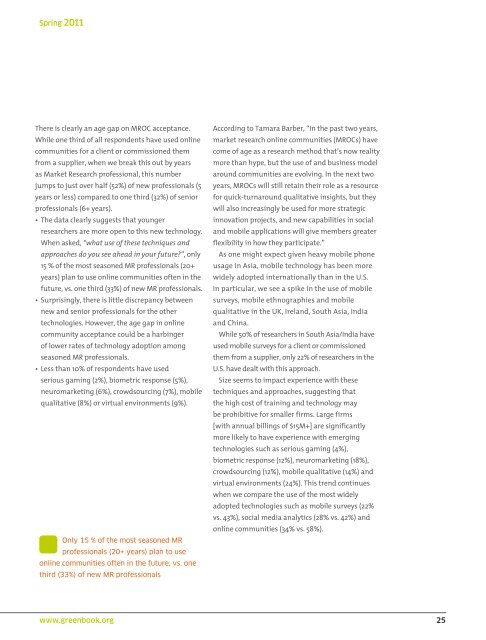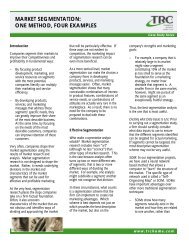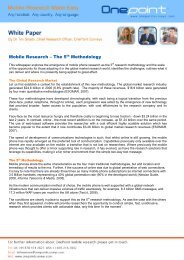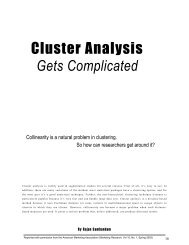GreenBook® Research Industry Trends Report
GreenBook® Research Industry Trends Report
GreenBook® Research Industry Trends Report
Create successful ePaper yourself
Turn your PDF publications into a flip-book with our unique Google optimized e-Paper software.
Spring 2011There is clearly an age gap on MROC acceptance.While one third of all respondents have used onlinecommunities for a client or commissioned themfrom a supplier, when we break this out by yearsas Market <strong>Research</strong> professional, this numberjumps to just over half (52%) of new professionals (5years or less) compared to one third (32%) of seniorprofessionals (6+ years).• The data clearly suggests that youngerresearchers are more open to this new technology.When asked, “what use of these techniques andapproaches do you see ahead in your future?”, only15 % of the most seasoned MR professionals (20+years) plan to use online communities often in thefuture, vs. one third (33%) of new MR professionals.• Surprisingly, there is little discrepancy betweennew and senior professionals for the othertechnologies. However, the age gap in onlinecommunity acceptance could be a harbingerof lower rates of technology adoption amongseasoned MR professionals.• Less than 10% of respondents have usedserious gaming (2%), biometric response (5%),neuromarketing (6%), crowdsourcing (7%), mobilequalitative (8%) or virtual environments (9%).Only 15 % of the most seasoned MRprofessionals (20+ years) plan to useonline communities often in the future, vs. onethird (33%) of new MR professionalsAccording to Tamara Barber, “In the past two years,market research online communities (MROCs) havecome of age as a research method that’s now realitymore than hype, but the use of and business modelaround communities are evolving. In the next twoyears, MROCs will still retain their role as a resourcefor quick-turnaround qualitative insights, but theywill also increasingly be used for more strategicinnovation projects, and new capabilities in socialand mobile applications will give members greaterflexibility in how they participate.”As one might expect given heavy mobile phoneusage in Asia, mobile technology has been morewidely adopted internationally than in the U.S.In particular, we see a spike in the use of mobilesurveys, mobile ethnographies and mobilequalitative in the UK, Ireland, South Asia, Indiaand China.While 50% of researchers in South Asia/India haveused mobile surveys for a client or commissionedthem from a supplier, only 22% of researchers in theU.S. have dealt with this approach.Size seems to impact experience with thesetechniques and approaches, suggesting thatthe high cost of training and technology maybe prohibitive for smaller firms. Large firms[with annual billings of $15M+] are significantlymore likely to have experience with emergingtechnologies such as serious gaming (4%),biometric response (12%), neuromarketing (18%),crowdsourcing (12%), mobile qualitative (14%) andvirtual environments (24%). This trend continueswhen we compare the use of the most widelyadopted technologies such as mobile surveys (22%vs. 43%), social media analytics (28% vs. 42%) andonline communities (34% vs. 58%).www.greenbook.org25







